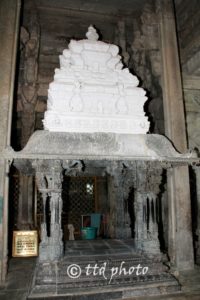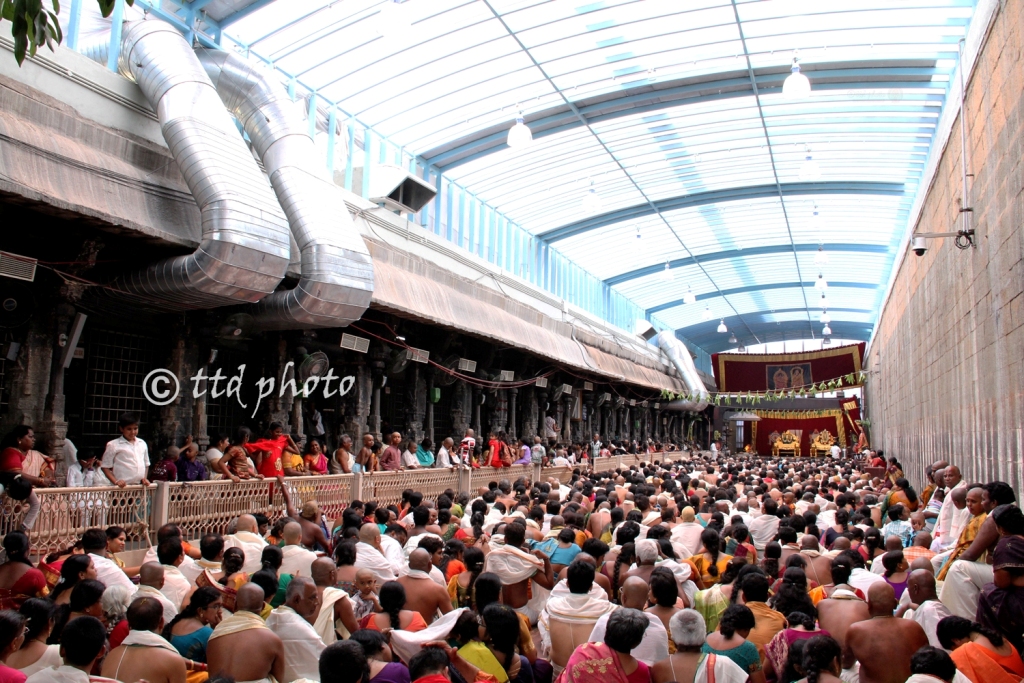Table of Contents
ToggleMandapams of Tirumala - Historical Marvel
The lush green forests of Seshachala house, Sri Venkateswara Swamy, who is also revered as Perumal, Venkatachalapati, Tirumalesa, Govinda, Balaji, Srinivasa and many more names.
Mandapams
The ancient temple of Lord Venkateswara in the hill shrine of Tirumala is an amazing complex of history, culture, and traditions. Almost every brick speaks volumes about the cultural journey of the temple over the past several centuries.
According to saint poet Sri Tallapaka Annamayya, the various Mandapams and constructions inside the Srivari temple served as shelters to the devotees at times of heavy rains and scorching summer besides being served as platforms for temple rituals and stand here to tell the volumes of history.
These temples not only have historical and mythological significance but also stand as architectural marvels. A peep into these mandapams:
- Dwajasthambha mandapam,
- Krishnadevaraya Mandapam,
- Four Pillar Mandapam,
- Ranganayakula Mandapam or Ranga Mandapam,
- Kalyanotsava Mandapam,
- Tirumalaraya Mandapam,
- Anna Unjal Mandapam,
- Addala Mandapam or Aina Mahal,
- Garuda Mandapam,
- Golla Mandapam,
- Sahasra Deepalankara Seva Mandapam etc.
Let us have a short glimpse related to these mandapams in this issue.
Anna Unjal Mandapam
The southern inner portion of this Mandapam was constructed by the Vijayanagara king Sri Saluva Narasimha to celebrate a festival for Sri Venkateswara called 'Anna Unjal Tirunal'.
In this Mandapam, during Brahmotsavam, the hoisting of the Garudadhwaja on Dhwajastambham to mark the commencement of Brahmotsavams will be done.
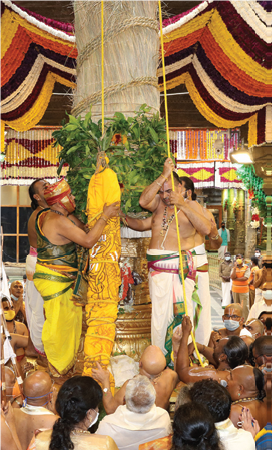
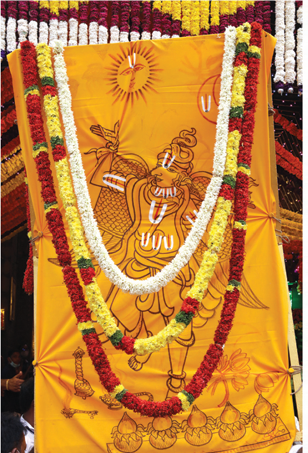
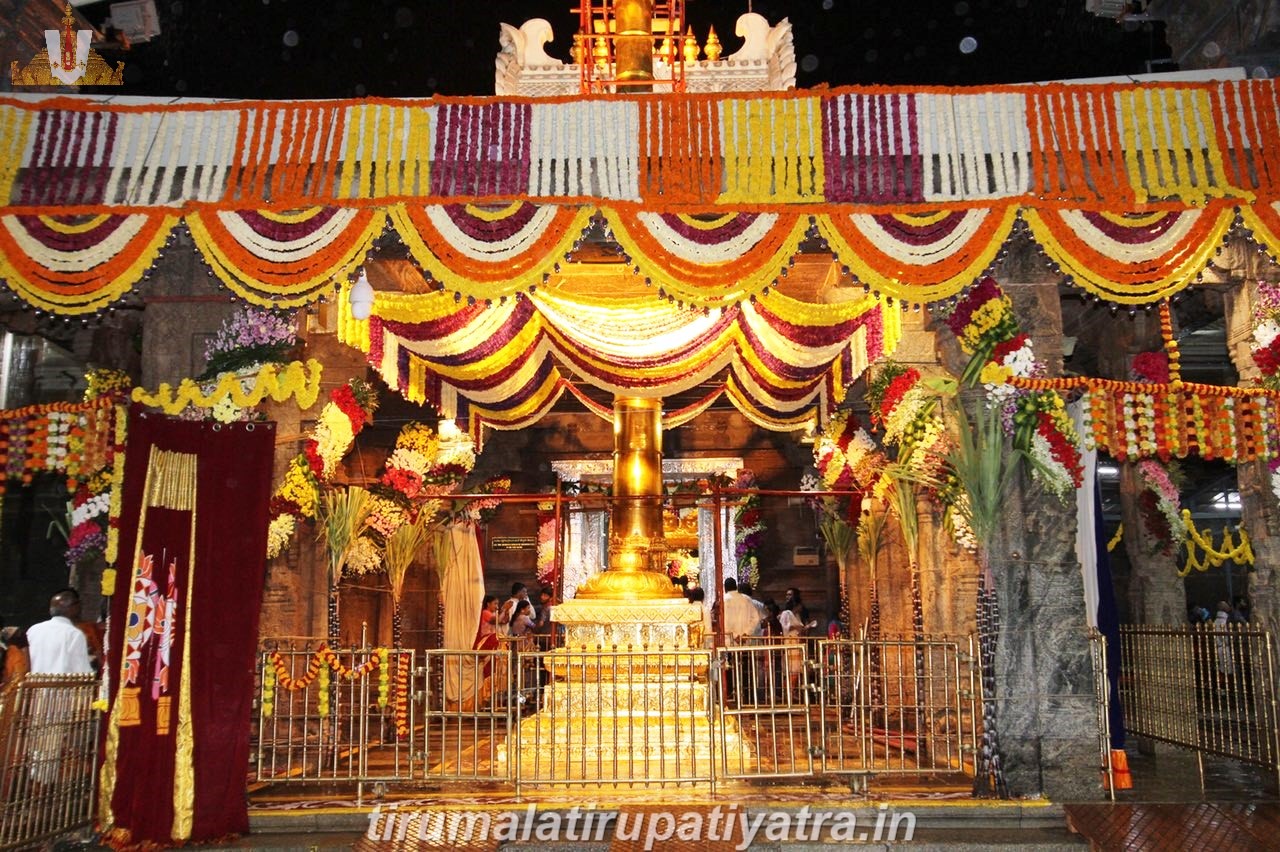
Dwajasthambha Mandapam
Dwajasthambham, the golden flagstaff is located in the middle of the temple. To the East of the flagstaff, there is an altar or Balipeetam and to the northeast, there is a stone called ‘Kshetrapalakasila’. This pavilion is said to have been constructed in the fifteenth century.
During Brahmotsavams, a flag with Garuda’s imprint is hoisted on this flagstaff to extend an invitation to gods and goddesses (Yaksha, Kinnera, and Gandharva), to attend this festival. Here devotees should make obeisance to Dhwajasthambam and Balipeetam before proceeding to the Lord's darshan.
Sri KrishnaDevaraya Mandapam
Abutting the Mahadwara and to its right, there is a high-rise mandapam (Porch). This is called Sri Krishnadevarayalu Mandapam or Pratima Mandapam. This mandapam was constructed in the Vijayanagara architectural style.
To the right side of this porch, one can find tall copper statues of the emperor of the Vijayanagara kingdom, Sri Krishnadevarayalu, and his two consorts, Tirumala Devi and Chinnadevi. These three statues placed in front of Lord Sri Venkateswara express their devotion to him.
It is said that Sri Krishnadevarayalu himself installed these statues and then onwards this mandapam has become famous as the Krishnadevarayalu Mandapam. Their names are inscribed on the shoulder badges of these statues.
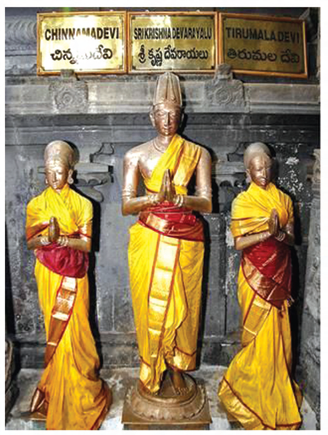
Ranganayaka Mandapam
After crossing the Main gateway, towards south of Sri Krishna Deva Raya Idol, there is one elevated stone platform. A Porch has been constructed. This porch is known as “Ranganayaka Mandapam”.
To safeguard the Ustava Moorthies of Sri Rangam from the invader Malik kaffer and for offering poojas to them at Tirumala, it is said the local ruler of Tirupati Ranganatha Yadava Rayulu had constructed this temple inside portico.
As Sri Rangantha’s Utsava Moorthies from sri Rangam were kept in Tirumala Temple, it is believed that reciting of Divya Prabandham and singing of Tiruppavai, The sri vaishnava tradition during Dhanur Masam were introduced in Tirumala temple.
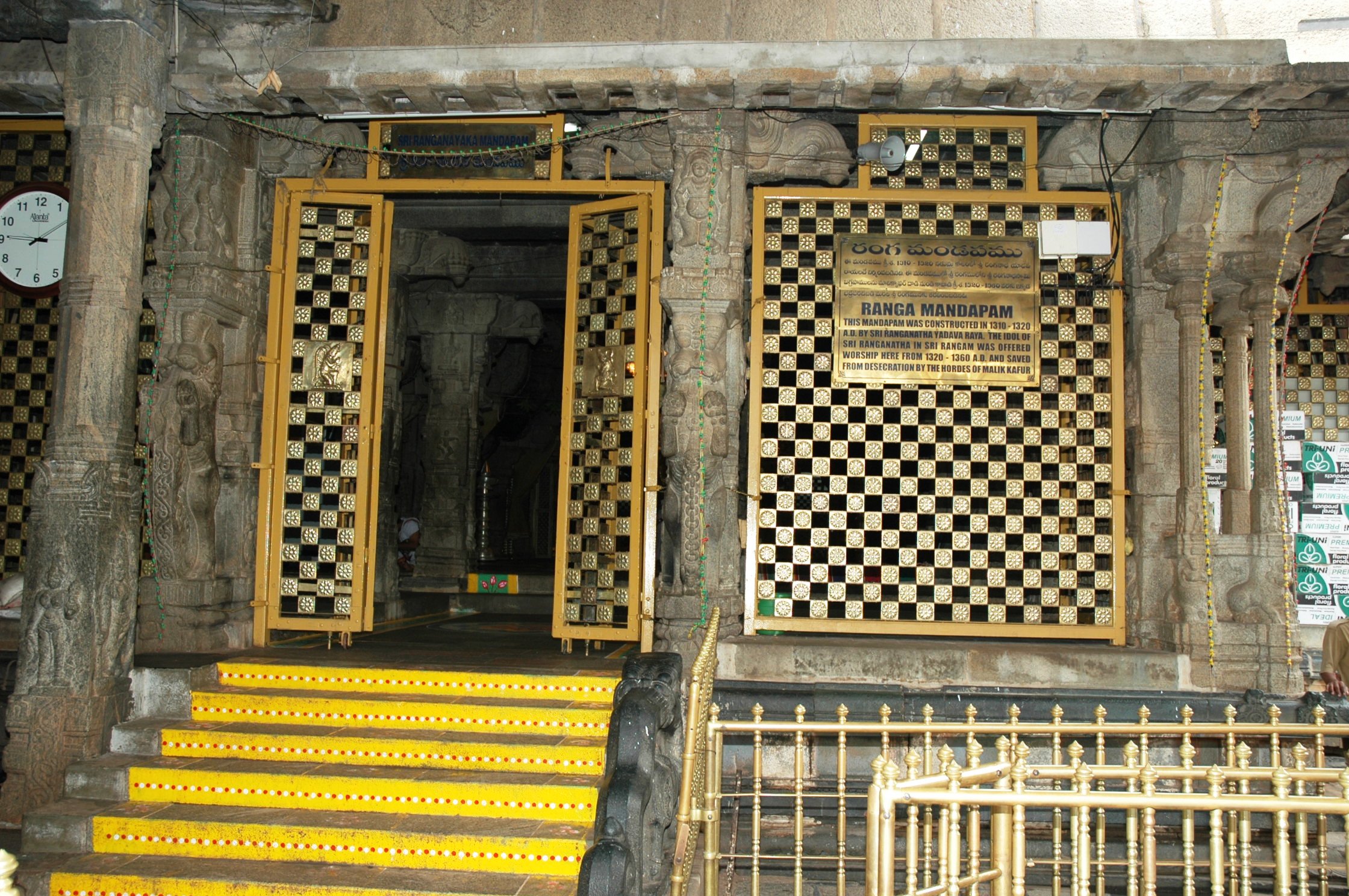
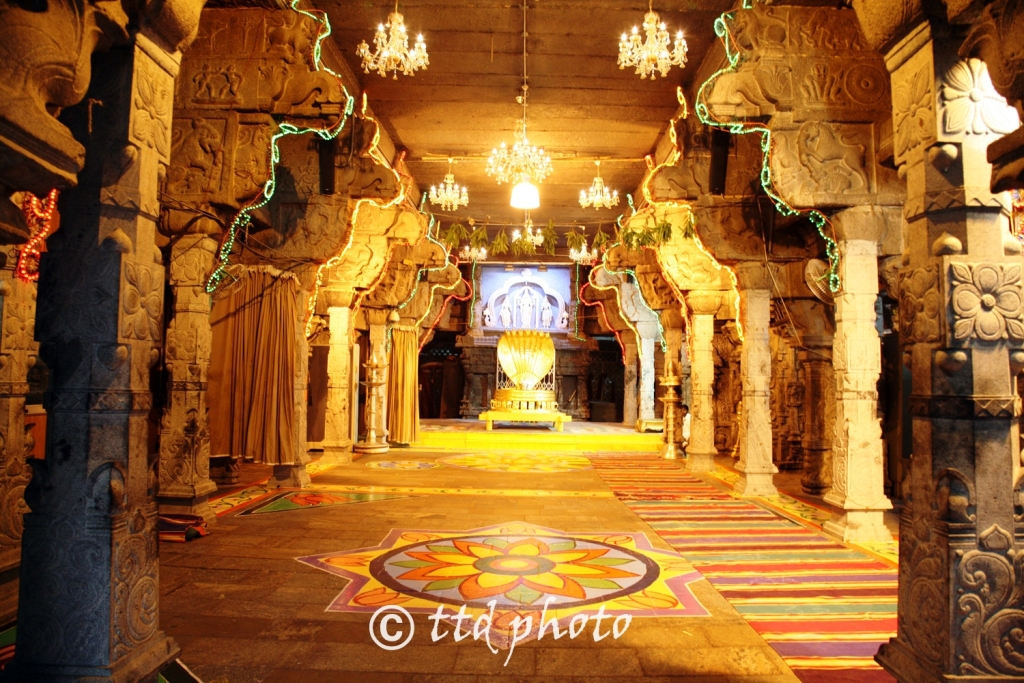
More on Ranganayakula Mandapam or Ranga Mandapam
Ranganayakula Mandapam was built in Vijayanagara-style architecture and decorated with floral carvings and tales and stories from Ramayana and other puranas on the pillars, walls, and ceiling.
It is said that, in the middle of the Southern end of Ranga Mandapam, there is a small Garbha Griha constructed, believed to accommodate and offer daily sevas to the Utsava Murthies of Sri Ranganadha Swamy of Srirangam, which were stationed here in Tirumala for a brief period and shielded from the Muslim invader Malik Kafur.
Snapana Tirumanjanam during the annual brahmotsavams are held here and Ranganadha Mandapam is fully decorated with various flowers and fruits for every event.
This Mandapam is also famous by the name Ranganayakula Mandapam.
Addala (Mirror) Mandapam Or Aina Mahal
The Aina Mahal or the Mirror Hall is on the northern side of the Tirumala Raya Mandapam.
It consists of two parts – an open mandapam in the front and a shrine behind it consisting of an Antarala and Garbhagriha. It has large mirrors which reflect the beauty and fiery of the idols infinitely from all angles when the unjal seva is performed.
The arjitha seva which is performed in the middle of the room every day with the Lord and His consorts seated on the golden unjal is called “Dolotsavam”.
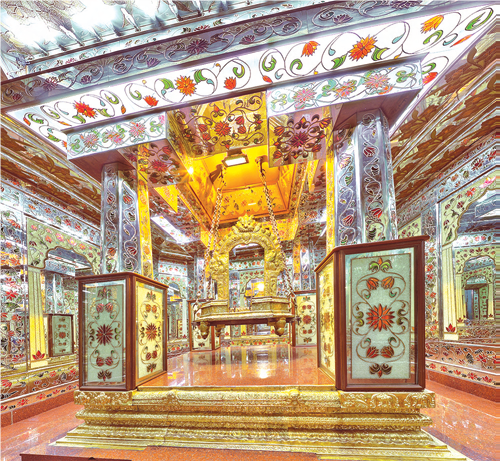
Garuda Mandapam
In the Sanctum Sanctorum, just opposite the golden gate and facing the Lord there is a six feet high statue of Garuda saluting the Lord with folded hands. Every day at the pre-dawn hour, Suprabhatham is recited in the place between the golden gate and the statue of Garuda.
The Lord sitting on the golden throne in this mandapam, listens to the recital of almanac and the submissions of receipt and expenditure account of the previous day.
Kalyana Mandapam or Kalyanotsava Mandapam.
Towards the south on the Sampangi Pradakshanam path, a marriage hall in a rectangular shape can be seen. This hall is covered with sheets. People call this hall by the name Sri Venkateswara Swamy Kalyana Mandapam (Lord’s Marriage Hall).
Earlier all wedding festivities of the Lord were celebrated at the pavilion in the ‘Vimana Pradakshinam’. With the increase in the number of devotees attending the events, these festivities started being held for some time in Ranganayaka Mandapam.
Now the wedding festivities of the Lord Malayappa swami Varu are celebrated at this pavilion. Now, hence this place is called Kalyanotsava Mandapam.
This prakaram, in the olden days, was called Sampangi Praakaram, which is between the outer and inner prakarams of the temple. Pavitrotsavam, Pushpayagam and Jyestabhisekham are also performed here in this Kalyanotsava Mandapam.
As the Lord’s marriage is performed each and every day, you can see the green festoons beautifying the Mandapam.
In Telugu about Tirumala, they say “Nitya Kalyanam (Daily marriage) pachcha Thoranam”(green Festoons).
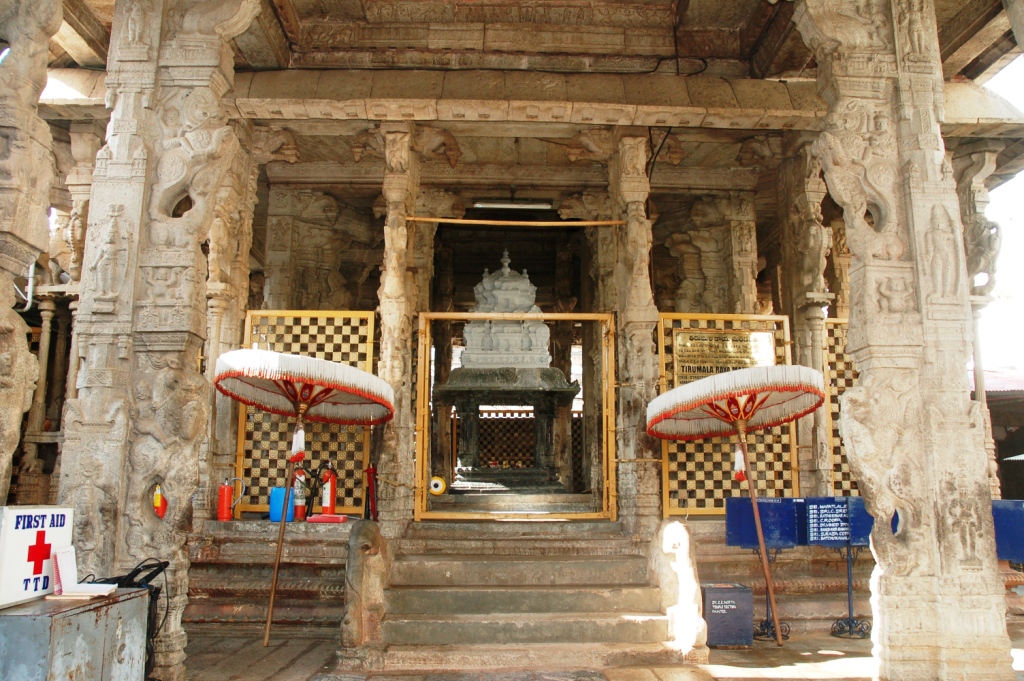
Tirumala Raya Mandapam.
Tirumala Raya Mandapam adjoining the Ranga Mandapam on the western side and facing the Dhvajasthambha Mandapam is a spacious complex of pavilions known as the Tirumala Raya Mandapam.
This was built by Saluvanarasimharayalu, the emperor of Vijayanagara, to express his gratitude to the Lord for the help extended towards his victories. It consists of two different levels, the front at a lower level and the rear at a higher carved in black granite stone with Vijayanagara architecture.
The Mandapam has a typical complex of pillars in the Vijayanagara style with rear carvings.
Mahamani Mandapam
‘Mani’ means bell in Tamil. Mahamani means big bell.
Where there are big bells, that place is called Mahamani mantapam.
Generally there will be only one bell in any temple. But in Tirumala there are two bells. One is ‘ Narayana Bell’ and the other is ‘ Govinda Bell’.
The bell is important for any temple. The sound of bell indicates that pujalu and Nivedanalu are being performed.
